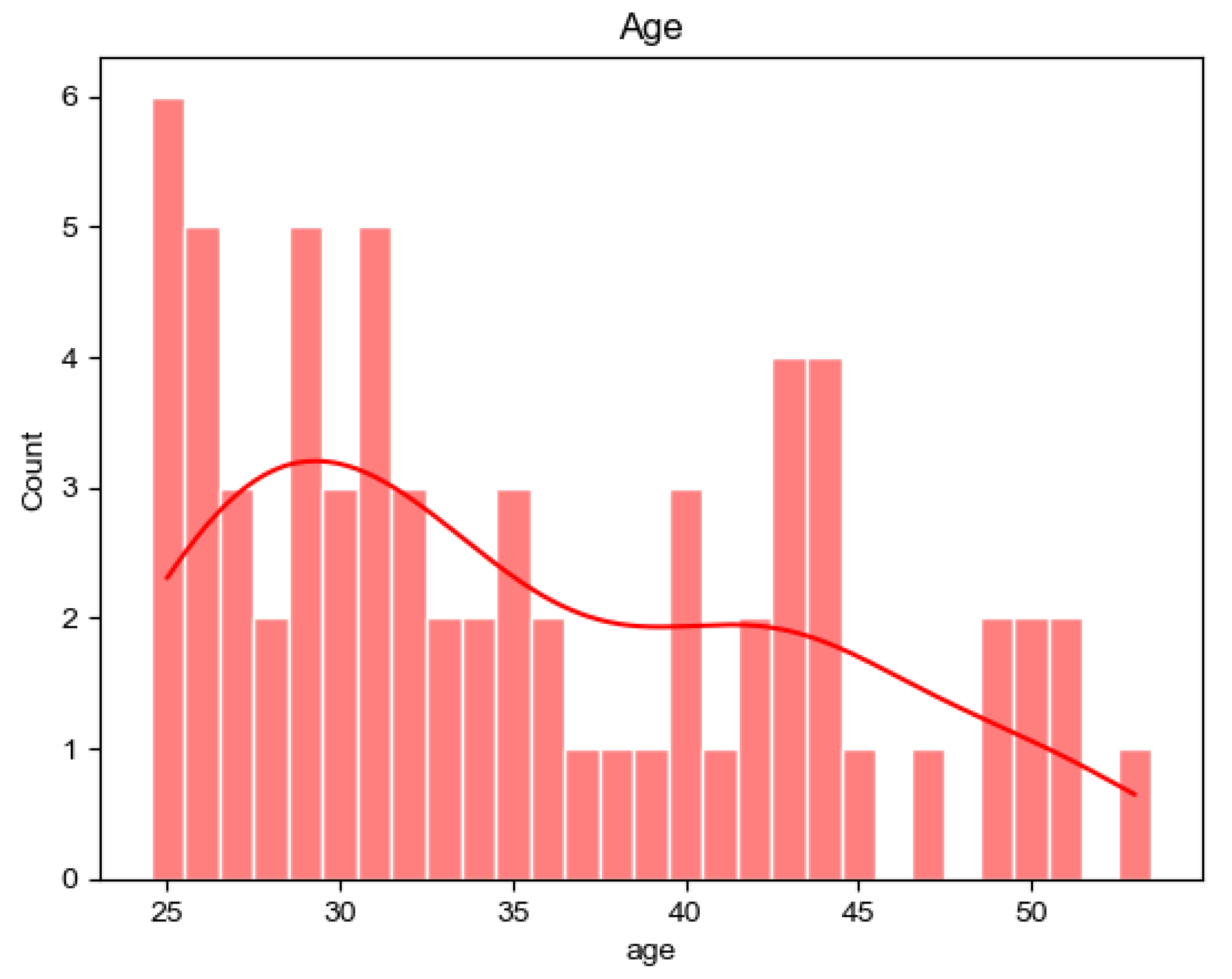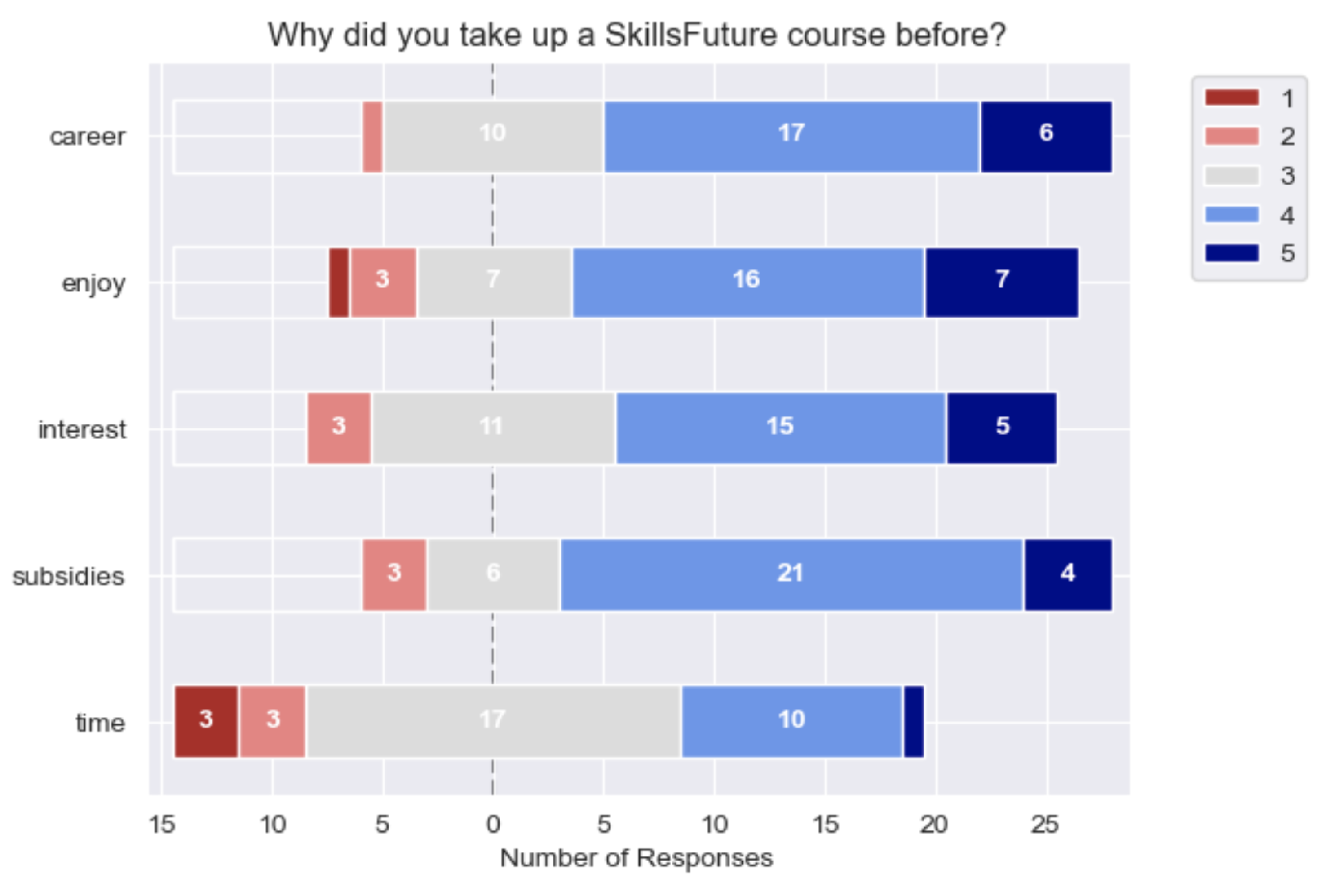Unraveling the Dynamics of Lifelong Learning in Singapore: A Comparative Study
Abstract
:1. Introduction
1.1. SkillsFuture’s History and Importance
1.2. Research Aims
2. Methods
2.1. Data Collection
- Group 1: individuals who had previously enrolled in non-SkillsFuture courses (33 participants);
- Group 2: individuals who were undertaking their first SkillsFuture course (19 participants);
- Group 3: individuals who had enrolled in SkillsFuture courses more than once (15 participants).
- Word-of-mouth;
- Social media;
- Search engines;
- TV/radio/newspapers;
- Other.
- To help in their career progression (“career progression”);
- Because they enjoy learning (“enjoy learning”);
- Because of the available subsidies (“available subsidies”);
- Because the course/workshop was interesting (“interesting content”));
- To fill in their spare time (“spare time”).
2.2. General Properties
3. Results
3.1. Exposure to the Courses
3.1.1. Non-SkillsFuture Course Takers
- Sponsored by their company (5);
- Not entitled for SkillsFuture subsidies (7);
- SkillsFuture courses not interesting/relevant/accessible (7).
3.1.2. Skillsfuture Course Takers
3.2. Reasons for Taking up the Course(s)
3.2.1. Non-Skillsfuture Courses
3.2.2. Skillsfuture Courses
3.2.3. Comparative Statistics
4. Discussion
4.1. Course Exposure
4.2. Reasons for Taking up the Courses
5. Conclusions
Author Contributions
Funding
Institutional Review Board Statement
Data Availability Statement
Conflicts of Interest
References
- Fung, M.; Taal, R.; Sim, W. SkillsFuture: The Roles of Public and Private Sectors in Developing a Learning Society in Singapore. In Powering a Learning Society During an Age of Disruption; Ra, S., Jagannathan, S., Maclean, R., Eds.; Springer: Singapore, 2021; Volume 58, pp. 195–208. [Google Scholar] [CrossRef]
- Oh, P.H.; Trenerry, B.; Nair, S.; Chng, S.; Lim, S.S.; Araral, E. Job Seekers’ Learning Attitudes in the Face of Digital Disruptions and the COVID-19 Pandemic: Investigating an Upskilling Programme in Singapore. In Proceedings of the 7th Conference of the Regulating for Decent Work Network, Virtual Conference, 6–9 July 2021; International Labour Office: Geneva, Switzerland, 2021. [Google Scholar]
- Demir, O.; Aslan, S.A.; Demir, M. Examining the relationship between teachers’ lifelong learning tendencies and digital literacy levels. J. Educ. Technol. Online Learn. 2022, 5, 379–392. [Google Scholar] [CrossRef]
- Blume, B.D.; Ford, J.K.; Baldwin, T.T.; Huang, J.L. Transfer of training: A meta-analytic review. J. Manag. 2010, 36, 1065–1105. [Google Scholar] [CrossRef]
- Grossman, R.; Salas, E. The transfer of training: What really matters. Int. J. Train. Dev. 2011, 15, 103–120. [Google Scholar] [CrossRef]
- Kumar, P. Lifelong learning in Singapore: Where are we now? Int. J. Lifelong Educ. 2004, 23, 559–568. [Google Scholar] [CrossRef]
- Lee, M.; Morris, P. Lifelong learning, income inequality and social mobility in Singapore. Int. J. Lifelong Educ. 2016, 35, 286–312. [Google Scholar] [CrossRef]
- Skills Demand for the Future Economy. Available online: https://www.skillsfuture.gov.sg/skillsreport (accessed on 7 July 2023).
- Kim, S.; Chen, Z.W.; Tan, J.Q.; Mussagulova, A. A case study of the Singapore SkillsFuture Credit scheme: Preliminary insights for making lifelong learning policy more effective. Asian J. Political Sci. 2021, 29, 192–214. [Google Scholar] [CrossRef]
- Woo, J.J. Educating the developmental state: Policy integration and mechanism redesign in Singapore’s SkillsFuture scheme. J. Asian Public Policy 2018, 11, 267–284. [Google Scholar] [CrossRef]
- Tan, C. Lifelong learning through the SkillsFuture movement in Singapore: Challenges and prospects. Int. J. Lifelong Educ. 2017, 36, 278–291. [Google Scholar] [CrossRef]
- Hanh Quyen, N.T. An Analysis of the Singaporean Preparation for the Future Workforce and Recommendations for Vietnam. VNU J. Foreign Stud. 2019, 35, 4397. [Google Scholar] [CrossRef]
- Loke, H.Y.; Gopinathan, S. The Policy and Politics of the Cohort Participation Rate in Universities: The Case of Singapore and “SkillsFuture”. Int. J. Chin. Educ. 2016, 5, 209–225. [Google Scholar] [CrossRef]
- Dikhtyar, O.; Helsinger, A.; Cummins, P. Adult education and the impacts of the COVID-19 pandemic: An international perspective. Widening Particip. Lifelong Learn. 2021, 23, 201–210. [Google Scholar] [CrossRef]
- James, D. Is lifelong learning still useful? Disappointments and prospects for rediscovery. J. Educ. Work. 2020, 33, 522–532. [Google Scholar] [CrossRef]
- Mokhtar, F. New “recommended” skillsfuture courses rolled out for emerging fields. Available online: https://www.todayonline.com/singapore/new-recommended-skillsfuture-courses-rolled-out-emerging-fields (accessed on 7 July 2023).
- Sung, J.; Freebody, S. Lifelong learning in Singapore: Where are we? Asia Pac. J. Educ. 2017, 37, 615–628. [Google Scholar] [CrossRef]
- Encouraging Individuals to Take Ownership of Their Skills Development And Learning Journey. Available online: https://www.skillsfuture.gov.sg/initiatives/early-career/credit (accessed on 19 April 2023).
- Goldsticker, R.P.; Agrrawal, P. The effects of blending primary and diluted EPS data. Financ. Anal. J. 1999, 55, 51–60. [Google Scholar] [CrossRef]
- Virtanen, P.; Gommers, R.; Oliphant, T.E.; Haberland, M.; Reddy, T.; Cournapeau, D.; Burovski, E.; Peterson, P.; Weckesser, W.; Bright, J.; et al. SciPy 1.0: Fundamental Algorithms for Scientific Computing in Python. Nat. Methods 2020, 17, 261–272. [Google Scholar] [CrossRef]
- Maier, M.; Lakens, D. Justify your alpha: A primer on two practical approaches. Adv. Methods Pract. Psychol. Sci. 2022, 5, 25152459221080396. [Google Scholar] [CrossRef]
- Lim, Z.Y.; Munshi, T.; Yap, J.H.; Mishra, A.; Lai, J.W.; Yeo, D.J.; Cheong, K.H. Using opinion dynamics to identify groups for targeted intervention in lifelong learning: A case study of SkillsFuture in Singapore. Int. J. Mod. Phys. B 2023. [Google Scholar] [CrossRef]
- Niman, N.B.; Chagnon, J.R. Industry Professionals in the Classroom. In The Work-Ready Graduate: Preparing Tomorrow’s Workforce; Springer: Berlin/Heidelberg, Germany, 2023; pp. 145–161. [Google Scholar]
- Moustakas, L. Motivation and obstacles to adult participation in lifelong learning programs: The effect of gender and age. Open J. Educ. Res. 2018, 2, 45–56. [Google Scholar] [CrossRef]
- Park, J.H.; Choi, H.J. Factors Influencing Adult Learners’ Decision to Drop Out or Persist in Online Learning. Educ. Technol. Soc. 2009, 12, 207–217. [Google Scholar]
- Gilbert, F.W.; Harkins, J.; Agrrawal, P.; Ashley, T. Internships as Clinical Rotations in Business: Enhancing Access and Options. Int. J. Bus. Educ. 2021, 162, 126–140. [Google Scholar]
- Yadav, M.; Banerji, P. A bibliometric analysis of digital financial literacy. Am. J. Bus. 2023, 38, 91–111. [Google Scholar] [CrossRef]
- Schuhen, M.; Kollmann, S.; Seitz, M.; Mau, G.; Froitzheim, M. Financial literacy of adults in Germany FILSA study results. J. Risk Financ. Manag. 2022, 15, 488. [Google Scholar] [CrossRef]










| Kruskal-Wallis H Test | Mann-Whitney U Test | |||
|---|---|---|---|---|
| Career progression | 0.01 | 0.92 | 309 | 0.93 |
| Enjoy learning | 1.09 | 0.30 | 261 | 0.30 |
| Available subsidies | 1.01 | 0.31 | 262 | 0.32 |
| Interesting content | 0.29 | 0.59 | 340 | 0.59 |
| Spare time | 0.01 | 0.94 | 310 | 0.94 |
| Kruskal-Wallis H Test | Mann-Whitney U Test | |||
|---|---|---|---|---|
| Career progression | 0.12 | 0.73 | 233 | 0.74 |
| Enjoy learning | 2.82 | 0.09 | 176 | 0.10 |
| Available subsidies | 4.98 | 0.03 | 151 | 0.03 |
| Interesting content | 0.62 | 0.43 | 217 | 0.44 |
| Spare time | 0.75 | 0.39 | 210 | 0.39 |
| Kruskal-Wallis H Test | Mann-Whitney U Test | |||
|---|---|---|---|---|
| Career progression | 0.07 | 0.80 | 542 | 0.80 |
| Enjoy learning | 2.68 | 0.10 | 437 | 0.10 |
| Available subsidies | 3.71 | 0.05 | 413 | 0.05 |
| Interesting content | 0.001 | 0.94 | 556 | 0.95 |
| Spare time | 0.30 | 0.59 | 520 | 0.59 |
Disclaimer/Publisher’s Note: The statements, opinions and data contained in all publications are solely those of the individual author(s) and contributor(s) and not of MDPI and/or the editor(s). MDPI and/or the editor(s) disclaim responsibility for any injury to people or property resulting from any ideas, methods, instructions or products referred to in the content. |
© 2023 by the authors. Licensee MDPI, Basel, Switzerland. This article is an open access article distributed under the terms and conditions of the Creative Commons Attribution (CC BY) license (https://creativecommons.org/licenses/by/4.0/).
Share and Cite
Lim, Z.Y.; Lai, J.W.; Yap, J.H.; Mishra, A.; Mokhtar, I.A.; Yeo, D.J.; Cheong, K.H. Unraveling the Dynamics of Lifelong Learning in Singapore: A Comparative Study. Knowledge 2023, 3, 449-460. https://doi.org/10.3390/knowledge3030030
Lim ZY, Lai JW, Yap JH, Mishra A, Mokhtar IA, Yeo DJ, Cheong KH. Unraveling the Dynamics of Lifelong Learning in Singapore: A Comparative Study. Knowledge. 2023; 3(3):449-460. https://doi.org/10.3390/knowledge3030030
Chicago/Turabian StyleLim, Zhi Yong, Joel Weijia Lai, Jun Hong Yap, Ankit Mishra, Intan Azura Mokhtar, Darren J. Yeo, and Kang Hao Cheong. 2023. "Unraveling the Dynamics of Lifelong Learning in Singapore: A Comparative Study" Knowledge 3, no. 3: 449-460. https://doi.org/10.3390/knowledge3030030
APA StyleLim, Z. Y., Lai, J. W., Yap, J. H., Mishra, A., Mokhtar, I. A., Yeo, D. J., & Cheong, K. H. (2023). Unraveling the Dynamics of Lifelong Learning in Singapore: A Comparative Study. Knowledge, 3(3), 449-460. https://doi.org/10.3390/knowledge3030030








